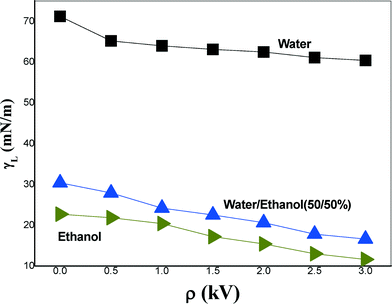Controlled formation of barium fluoride nanocrystals by electric-assisted phase separation and precipitation
Wei
Song
,
Kuo
Liu
,
Lei
Feng
and
Qing
Shen
*
State Key Laboratory for Modification of Chemical Fiber and Polymer Materials, Polymer Department of Donghua University, 2999 N. Renmin Rd., Songjiang, 201620 Shanghai, PR China. E-mail: sqing@dhu.edu.cn; Fax: +86 21 62822096; Tel: +86 21 62822096
First published on 29th April 2015
Abstract
This work demonstrated that barium fluoride (BaF2) nanocrystals can be controllably formed by an electric-assisted phase separation and precipitation method, EAPSP, in a water/ethanol mixture. Experimentally, we employed an electrostatic generator to provide various voltages to reduce the surface tension of a water/ethanol mixture to cause rapid phase separation after which BaF2 nanocrystals formed and precipitated under control. Results showed that the average diameter of the formed BaF2 nanocrystals was reduced with the voltage increase, e.g. the 0 V sample at about 70 nm in diameter, the 500 V sample at 50 nm in diameter and the 1000 V sample at 30 nm in diameter. The conductivity of these nanocrystals was found to increase with the decrease in size.
1. Introduction
Barium fluoride (BaF2) is one of the dielectric fluorides having a wide range of potential applications in microelectronic and optoelectronic devices, such as wide-gap insulating overlayers, gate dielectrics, insulators and buffer layers in semiconductor-on-insulator structures, and more advanced three dimensional structure devices.1–9 Recently studies have shown that BaF2 doped with rare-earth ions can display unique luminescence properties suitable for application in X-ray storage phosphors, scintillators, up-to-down conversion and ionic conductivity materials.3 According to the literature, the BaF2 particles can be prepared in various shapes, e.g. in nanowhiskers via a microemulsion-mediated hydrothermal method,3 in nanocubes by arching flake-like dendrites grown via reverse micelles4 or by hydrothermal precipitation in certain pH environments,5 in cubic-phase and orthorhombic-phase via the liquid–solid-solution approach6 and in a hollow nest-like nanostructure via ultrasound-assisted self-assembly.7The use of water/ethanol mixing solvents to precipitate BaF2 nanoparticles has been reported by Lv et al.,8 and according to them, the size of the BaF2 nanoparticles precipitated in water/ethanol was about 50 nm smaller than those precipitated in pure water, e.g. about 70 nm.8 The reason a water/ethanol mixture has advantages over water for the formation of nano-size particles is ascribed to the addition of a low dielectric medium in aqueous solution in the precipitation process altering the thermodynamics of the reaction system and nucleation kinetics, thus inducing reduction of the particle size and size distribution of the resulting particles.10 As reported, the water/alcohol mixed solution has also been applied as a media to form other nanoparticles11–16 and it was found that this mixture can enhance the reaction rate to reduce the precipitation time.8,10–16 It is true that the mixed solvent has been now applied as a new approach for synthesizing novel materials because it can not only change the dielectric property of the mixed solvent to affect the solubility of the inorganic salt molecules, but also influence the colloidal interaction between solid particles.10
In this work, we report a case for the controlled formation of BaF2 nanocrystals in a water/ethanol mixing solvent by using an electric-assisted phase separation and precipitation (EAPSP) method. Experimentally, an electrostatic generator was employed to provide adjustable voltages to control the surface tension of the water/ethanol mixture to cause the phase separation and precipitation rapidly and under control.
2. Experimental section
2.1 Materials
Ba(NO3)2 with a purity of 99.5% and NH4F with a purity of 99.5%, both of analytic grade, were obtained from a local chemical store in Shanghai and directly used without further purification.Ethanol (99.7%) was also purchased as mentioned above and was not treated further before use.
The lab-made distilled water was always used throughout the whole work.
2.2 Controlled formation of BaF2 nanocrystals in a water/ethanol mixture by an electric-assisted phase separation and precipitation method
Initially, a 20 ml water/ethanol mixing solvent was prepared by taking 10 ml of each and mixing them together with a magnetic stirrer for 30 min. Then, 0.8 g Ba(NO3)2 powder was dissolved in this water/ethanol mixing solvent to form a Ba2+ solution by stirring for 1 h at 25 °C. Meanwhile, a F−-solution was prepared by dissolution of 16 g NH4F powder in a water/ethanol mixing solvent (20 ml/20 ml) under the same stirring conditions as above. To maintain the stirring conditions, the F−-solution was then rapidly added into the Ba2+-solution to form the final mixing solution and stirred for 1 h at 25 °C.8,9The above prepared mixed solution was moved into a metal can where two electrodes from the electrostatic generator were linked to either the mixing solution or the metal can wall to form an electric cycle as described in Fig. 1. Under this electric field condition, the phase separation would occur controllably because the surface tension of the solvent would be gradually reduced with the voltage increase as discussed below to benefit the particles precipitation under control. The whole process was performed for 2 h, and the final precipitated product was filtered and oven dried for 24 h at 100 °C.
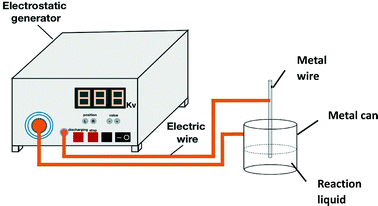 | ||
| Fig. 1 Scheme of the application of the electric-assisted phase separation and precipitation method to form nanocrystals. | ||
2.3 Measurement and characterization
The surface tension of the water/ethanol mixing solvent was measured using an electric-assisted Wilhelmy plate method, where an electrostatic generator was applied by taking its two electrodes respectively linked to both the solvent and the Wilhelmy plate under varied voltages from zero to 3 kV. During the measurement process, the platinum plate was initially wound with some Cu wires to increase its weight to avoid the effect from voltage increase induced swing. It was then hung above the solvent container. The measurement was started by raising the liquid-based container up to contact the bottom of the plate to form a contact angle which was meanwhile measured automatically by the tensiometer and presented on-screen to show the surface tension directly. Each presented value was an average of three independent measurements and the related standard deviation was about 2%. All measurements were performed at 25 °C.Before a field emission scanning electron microscopy (FESEM) image was taken, a sample was prepared by drop-casting an aqueous dispersion (∼1 g L−1) of the doped substituted sample onto a silicon wafer. A JEOL JSM-6700-F field emission SEM microscope was employed.
The Fourier transform infrared (FTIR) spectrum was recorded using a NEXUS 8700 (Nicolet, UK) in the range of 400–4000 cm−1 with the resolution of 4 cm−1. The KBr pellet technique was adopted to prepare all samples.
The X-ray diffraction (XRD) pattern was recorded by a Rigaku D/Max-2550 PC instrument (Rigaku, USA) at 40 kV and 30 mA, with Cu Kα monochromatic radiation with a wavelength of 1.5406 Å, after scanning in the 2θ range of 10–90° at intervals of 0.02.
The particle size was measured using a Malvern Zetasizer nanosizer at 25 °C.
The electrical conductivity was measured using an SDY-4 Four-Point Probe Meter at ambient temperature. The pellets were obtained by subjecting the powder samples to a pressure of 30 MPa. The measurement reproducibility was checked by measuring the resistance three times for each pellet.
3. Results and discussion
FESEM images and the particle size distribution of three BaF2 nanocrystals prepared with different applied voltages of 0, 500 and 1000 V are shown in Fig. 2. In terms of the FESEM images, these nanocrystals all showed a cubic morphology and uniform size in good agreement with the literature.1–9 This was strongly supported by the presented particle size distribution plot because each of the three samples showed a unique peak quantitatively giving size values corresponding to three applied voltages, respectively. Thus, it is clear that with the use of this novel EAPSP method one can controllably fabricate uniform inorganic nanostructures with controlled size.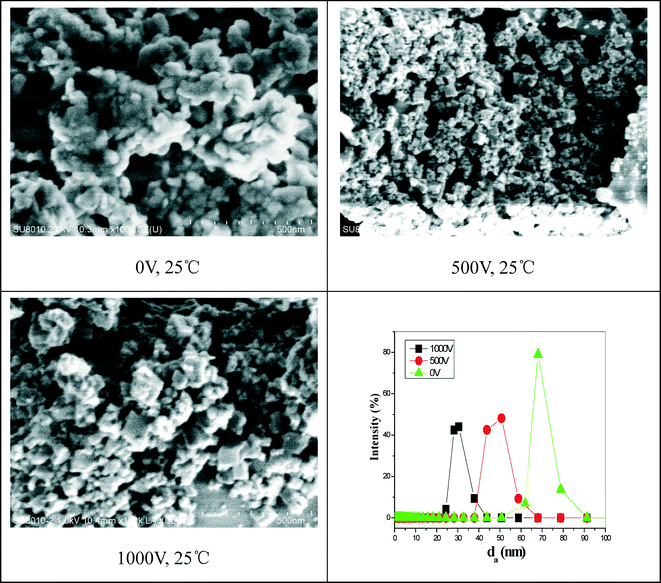 | ||
| Fig. 2 FESEM images and particle size distribution of BaF2 nanocrystals formed by an electric-assisted phase separation and precipitation method in a water/ethanol mixture. | ||
Fig. 2 (bottom right) shows that the BaF2 nanocrystals prepared at 1000 V had an average size of about 30 nm, which is not only the smallest reported in this work, but also comparable with samples prepared by other methods as summarized in Table 1.1–9,17,18 Though the literature has reported some cases on the formation of BaF2 nanocrystals,8,18 it seems to be true that the sample formed by the EAPSP method is uniform as can be seen in Fig. 2 showing SEM images and the particle size measurement.
| Samples | Voltage (V) | d a (nm) | Media | Ref. |
|---|---|---|---|---|
| BaF2 | 0 | 70 | Water/ethanol (1/1) | This work |
| BaF2 | 500 | 50 | Water/ethanol (1/1) | This work |
| BaF2 | 1000 | 30 | Water/ethanol (1/1) | This work |
| BaF2 | 0 | 55 | pH 2 solution | 5 |
| BaF2 | 0 | 200 | pH 4 solution | 5 |
| BaF2 | 0 | 1000 | pH 6 solution | 5 |
| BaF2 | 0 | 1000 | pH 7 solution | 5 |
| BaF2 | 0 | 800–900 | Surfactant-based solution | 7 |
| BaF2 | 0 | 70 | Water | 8 |
| BaF2 | 0 | 50 | Water/ethanol (1/1) | 8 |
| BaF2 | 0 | 61 | Water/ethanol (3/1) | 8 |
| BaF2 | 0 | 43 | Water/ethanol (3/5) | 8 |
| BaF2 | 0 | 34 | Water/ethanol (1/4) | 8 |
| BaF2 | 0 | 10–70 | Microemulsion | 9 |
| BaF2 | 0 | 40 | Microemulsion | 17 |
| BaF2 | 0 | 34 | Solution | 18 |
The XRD patterns of three EAPSP formed BaF2 nanocrystals are presented and compared in Fig. 3. As seen in Fig. 3, all three samples gave intense and consistent peaks well indexed to the phase-pure crystalline BaF2 with a cubic structure with the face-centered lattice (space group Fm3m) and the lattice constant a = 6.20 Å, in good agreement with the literature (JCPDS Card no. 85-1342).1–9
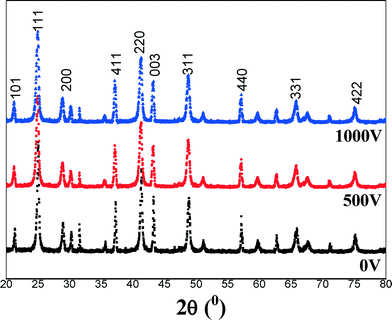 | ||
| Fig. 3 XRD patterns of BaF2 nanocrystals prepared by electric-assisted phase separation and precipitation. | ||
In terms of the XRD patterns presented in Fig. 3, the BaF2 nanocrystal growth is mainly along the 111 and 220 planes.5,7,19,20 The presented intensity is the highest for the 1000 V sample and smallest for the 0 V sample (Fig. 3). This indicated that the formed nanocrystal size is reduced with the voltage increase, supporting the SEM results (Fig. 2) as mentioned above. This again implied that the pure BaF2 nanocrystal can be better formed under electric field conditions.
The FTIR spectra of the three EAPSP formed BaF2 nanocrystals, corresponding to the applied voltages of 0, 500 and 1000 V, were presented in Fig. 4. It was found that the 0 V sample showed visible bands at 3341, 3136, 3041, 2095, 1531, 1428, 1259, 1040, 732, 556 and 483 cm−1 in agreement with previously reported literature.21 A comparison found that the 500 and 1000 V formed samples were both missing two peaks at 2095 and 1259 cm−1 corresponding to the removal of NH4+, and one peak shifted upward from 1531 to 1626 cm−1 corresponding to the removal of water. This indicated that the use of the EAPSP method formed purified BaF2 nanocrystals except for the normal 0 V prepared sample. This is reasonable because the EAPSP process would reduce the surface tension of the solvent as presented in Fig. 5, therefore benefiting the mixed solvent to allow ease of evaporation.
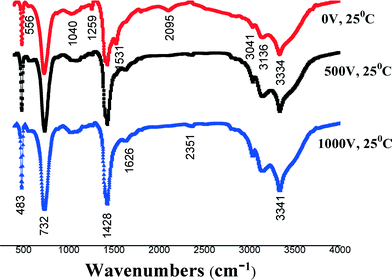 | ||
| Fig. 4 FTIR spectra of BaF2 nanocrystals prepared by electric-assisted phase separation and precipitation method. | ||
It was clearly observed that the surface tensions of either the pure water and ethanol or their mixture all were reduced with the voltage increase. This result is in good agreement with our recent reports.22–24 In terms of Fig. 5, the water/ethanol mixture showed a low surface tension similar to the pure ethanol. Therefore, this low surface tension-based water/ethanol mixing solvent should play an interesting role during the EAPSP process that the pure water and ethanol are unable to. This was well supported by Chen and Chang10 because they have applied several water/alcohol mixtures to form cerium dioxide nanocrystals and found that the smallest size could be formed by the lowest surface tension-based mixture.
Hence, the binding between the Ba2+ and F− ions is enhanced for EAPSP formed samples.
The conductivity of BaF2 nanocrystals has been a focus of researchers due to this property strongly affecting their application.20,25,26Fig. 6 presents a plot where the conductivity of the BaF2 samples was found to increase with the increase in the applied voltage. This importantly implied that the use of this novel EAPSP method can allow for the controllable formation of BaF2 nanocrystals with the required electric properties.
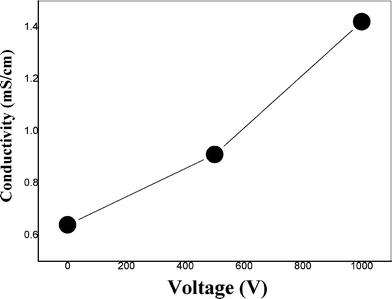 | ||
| Fig. 6 Effect of applied voltages on the conductivity of BaF2 nanocrystals prepared by electric-assisted phase separation and precipitation. | ||
It is noted that the conductivity values presented in Fig. 6 are greater as compared to the literature reported values for BaF2 nanocrystals.20,26 For example, Ruprecht et al.20 applied a high-energy ball milling method to prepare nanocrystalline BaF2:CaF2 composites and found the conductivity to be about 0.1 mS cm−1 at 450 K. In fact, our samples presented greater conductivities as measured at 295 K as compared with the literature reported values measured at 450 K.20
According to the above discussion, a related mechanism on the formation of BaF2 nanocrystals in a water/ethanol mixture via this novel EAPSP process was elucidated. Because the presence of an electric field led to a reduction in the surface tension of this particle/mixing solvent system and the evaporation of ethanol and water was enhanced with the voltage increase, this thus led to the occurrence of phase separation and enhanced the collision of particles to finally lead to the precipitation of BaF2 nanocrystals.
4. Conclusion
In summary, BaF2 nanocrystals can be successfully prepared with controlled size and property by using a novel electric-assisted phase separation and precipitation method in a water/ethanol mixing solvent. This work has proven that the voltage increase can reduce the surface tension of the mixing solvent to form uniform BaF2 nanocrystals.Notes and references
- A. J. Wojtowicz, Nucl. Instrum. Methods Phys. Res., Sect. A, 2002, 486, 201 CrossRef CAS
.
- L. Zhu, J. Meng and X. Q. Cao, J. Solid State Chem., 2007, 180, 3101 CrossRef CAS PubMed
.
- M. H. Cao, C. W. Hu and E. B. Wang, J. Am. Chem. Soc., 2003, 125, 11196 CrossRef CAS PubMed
.
- H. Z. Lian, Z. R. Ye and C. S. Shi, Nanotechnology, 2004, 15, 1455 CrossRef CAS
.
- P. Gao, Y. Xie and Z. Li, Eur. J. Inorg. Chem., 2006, 3261–3265 CrossRef CAS PubMed
.
- T. Xie, S. Li, Q. Peng and Y. D. Li, Angew. Chem., Int. Ed., 2009, 48, 196 CrossRef CAS PubMed
.
- J. Geng, F. Jiang, Q. Lu and J. J. Zhu, CrystEngComm, 2011, 13, 2758–2763 RSC
.
- Y. F. Lv, X. J. Wu, D. X. Wu, D. Huo and S. Zhao, Powder Technol., 2007, 173, 174–178 CrossRef CAS PubMed
.
- Y. F. Lv, X. J. Wu, D. X. Wu and G. H. Wang, J. Mater. Sci. Eng., 2006, 24, 196–199 CAS
(In Chinese).
- H. I. Chen and H. Y. Chang, Colloids Surf., A, 2004, 242, 61–69 CrossRef CAS PubMed
.
- M. Z. C. Hu, E. A. Payzant and C. H. Byers, J. Colloid Interface Sci., 2000, 222, 20 CrossRef CAS PubMed
.
- C. S. Fang and Y. W. Chen, Mater. Chem. Phys., 2003, 78, 739 CrossRef CAS
.
- J. Y. Choi and D. K. Kim, J. Sol–Gel Sci. Technol., 1999, 15, 231 CrossRef CAS
.
- H. K. Park, Y. T. Moon, D. K. Kim and C. H. Kim, J. Am. Ceram. Soc., 1996, 79, 2727 CrossRef CAS PubMed
.
- H. K. Park, D. K. Kim and C. H. Kim, J. Am. Ceram. Soc., 1997, 80, 743 CrossRef CAS PubMed
.
- W. Li and L. Gao, Ceram. Int., 2001, 27, 543 CrossRef CAS
.
- R. N. Hua, C. Y. Zang, C. Sha, D. M. Xie and C. S. Shi, Nanotechnology, 2003, 14, 588–591 CrossRef CAS
.
- R. N. Grass and W. J. Stark, Chem. Commun., 2005, 1767–1769 RSC
.
- R. Sang, Y. Li, X. Ma, Z. Cui and Y. Liu, Mater. Chem. Phys., 2014, 143, 1315–1318 CrossRef CAS PubMed
.
- B. Ruprecht, M. Wilkening, S. Steuernagel and P. Heitjans, J. Mater. Chem., 2008, 18, 5412–5416 RSC
.
- A. A. Luginina, A. E. Baranchikov, A. I. Popov and P. P. Fedorov, Mater. Res. Bull., 2014, 49, 199–205 CrossRef CAS PubMed
.
- C. M. Bender and J, M. Burlitch, Chem. Mater., 2000, 12, 1969–1976 CrossRef CAS
.
- S. Zhai, J. R. Ye, N. Wang, L. H. Jiang and Q. Shen, J. Mater. Chem. C, 2014, 2, 7168–7172 RSC
.
- J. R. Ye, L. Chen, Y. Zhang, Q. C. Zhang and Q. Shen, RSC Adv., 2014, 4, 58200–58203 RSC
.
- D. C. Sayle, J. A. Doig, S. C. Parker and G. W. Watson, Chem. Commun., 2003, 1804–1806 RSC
.
- N. I. Sorokin, I. I. Buchinskaya, P. P. Fedorov and B. P. Sobolev, Inorg. Mater., 2008, 44, 189–192 CrossRef CAS
.
| This journal is © The Royal Society of Chemistry 2015 |

